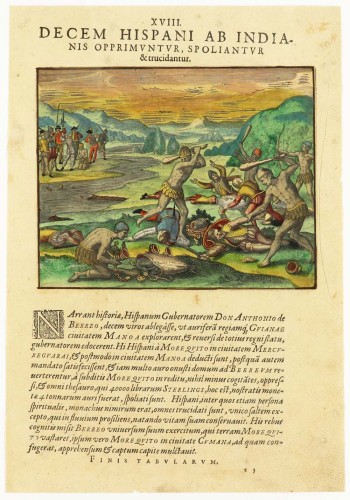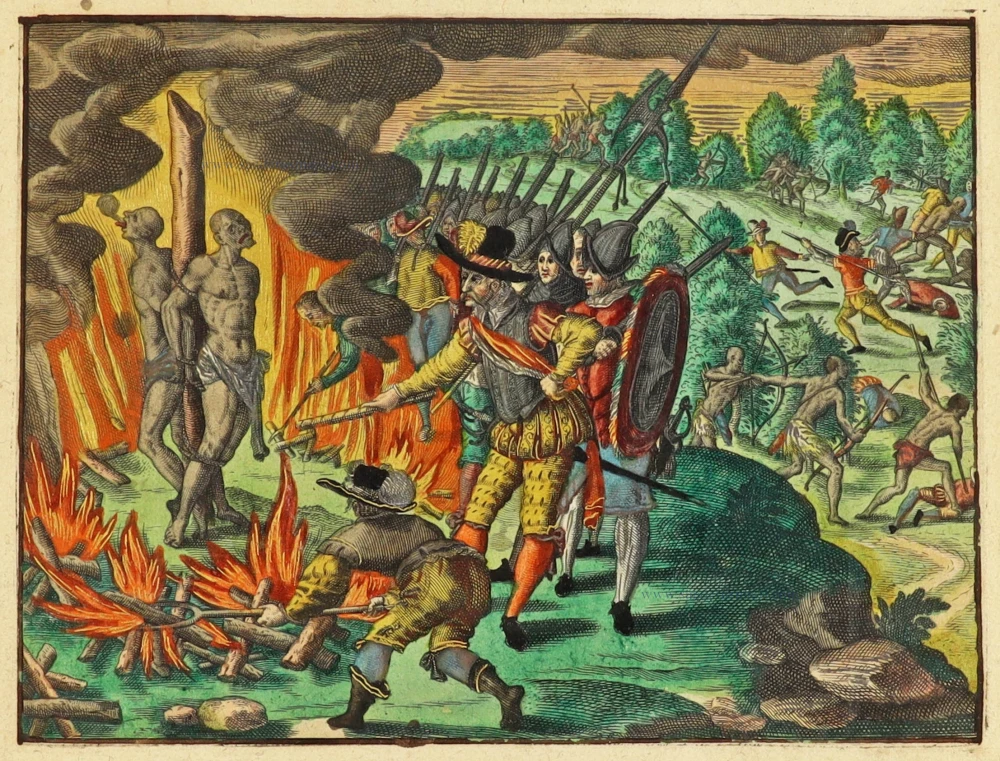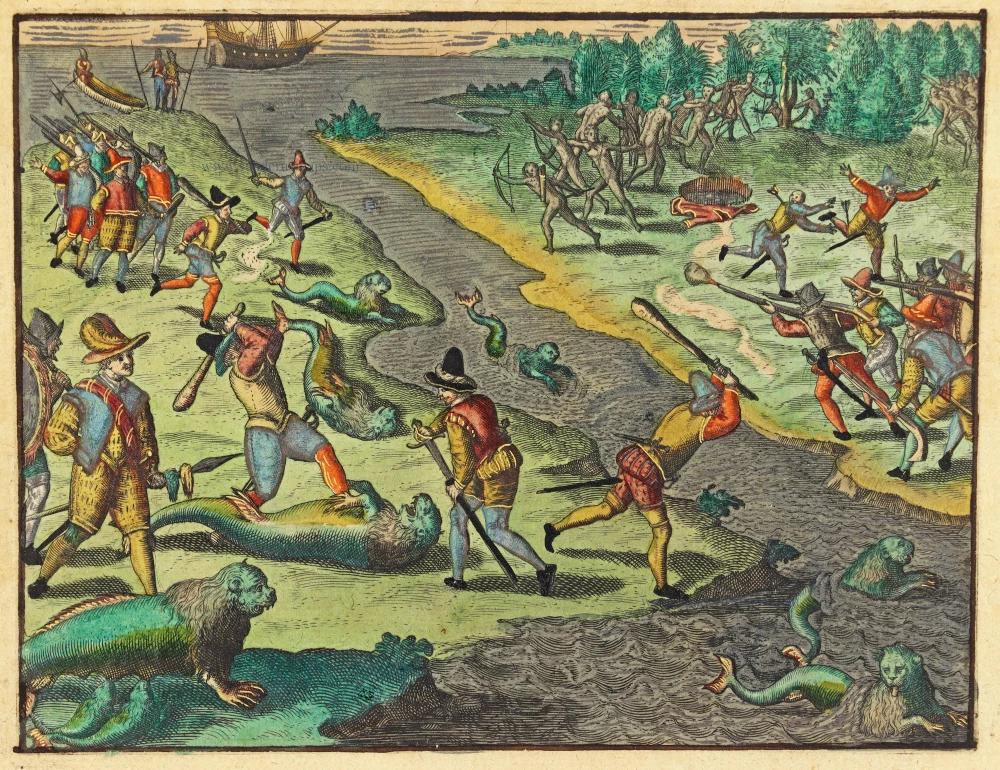Heightened in gold and silver
Concerning the 10 Spaniards who were attacked, beaten and robbed by the Indians. Great Voyages, De Bry. 1599
TRANSLATION: "The account mentions how the Spanish governor Don Antonio de Berrio sent out 10 of his men on a reconnaissance mission to the gold-rich capital of Manoa and the surrounding area. These Spaniards were accompanied by Morequito to Mercureguarai, and from there on to Manoa. When they reckoned they had done what they had been instructed to do, and had also acquired for themselves all manner of riches from that country, they decided to return, having no longer any concern for possible dangers. It was then that Morequito told his people to overwhelm them most treacherously, and take possession of all the riches they had collected, amounting in value to some 40,000 pounds sterling. The Spaniards, one of whom was a monk, were all beaten and one of them jumped into the river and was killed with arrows. When Berrio heard of this, he sent all his forces to burn and plunder Morequito's country, and to pursue him all the way to Cumana, where he had fled, and there they found him and beheaded him." (Van Groesen - Tise)
Theodore de Bry (1528 – 1598) and his family.
Theodore de Bry was born in 1528 in the Prince-Bishopric of Liège in the southern Netherlands (today Belgium). Trained as a goldsmith in his father's workshop, he left his home town around 1558 and moved to Strasbourg. Religious motives partly inspired his emigration, but commercial incentives were probably more critical for de Bry since Strasbourg was more attractive. Here, he gradually began to shift his focus to copper engraving. In the early 1560s, Theodore married Strasbourg-born Katharina Esslinger, and the couple went on to have four children together before Katharina died c. 1569. Johan Theodore (b. 1563) and Johan Israel (b. 1565) followed in their father's footsteps and took up his trade. He remarried in 1570 to Katharina Rölinger.
In 1577, after the Pacification of Gent had quietened religious tensions in the Netherlands, Theodore and his family moved to Antwerp. There, they lived close to the printing house of Christopher Plantin, and it was there that Theodore began making copper engravings. Copper engraving was a well-developed art in the Low Countries, and Antwerp artists were in great demand. In 1584, when Catholic troops besieged Antwerp, Theodore and his family moved to London, where he made copper engravings for an essential English navigation manual, The Mariners Mirrour. He also found the inspiration to produce the collection to which his name would forever be attached.
He met the artist Jacques Le Moyne de Morgues, a draughtsman who had been to Florida in the 1560s as part of a French expedition. He returned to Europe with watercolours of the natural world he had seen and the indigenous peoples. After Le Moyne's death, thanks to the mediation of Richard Hakluyt, Theodore acquired these drawings.
Hakluyt and de Bry began collaborating on a series of books about America. In 1588, the de Bry family moved to Frankfurt, where Theodore published the first volume of the America series. This first volume was the only one in the collection that appeared in four different languages: German, Latin, French and English. The following volumes appeared only in German and Latin. As a result, the relationship between de Bry and his English partners quickly soured.
Theodore continued publishing and produced a blend of richly illustrated prestigious volumes of the Voyages collection, the family firm's flagship publication.
Theodore de Bry died on March 27th, 1598. At this time, the highly successful and lucrative America series had already extended to seven volumes, and there would be fourteen. To these must be added the 'Elenchus', published in 1634 by Merian, which was a collective title and table of contents of these same volumes.
In 1597, the de Bry brothers published the first volume of the East India series. These were also published in folio but with slightly smaller page sizes than the America volumes. To distinguish the East India series from his America series, the two parallel sets subsequently became known among bibliophiles as de Bry’s Petits Voyages and his Grands Voyages, respectively.
The Petits Voyages consist of thirteen volumes, published between 1597 and 1633.
After Theodore de Bry's death, the business was run by his son, Johann Theodore and then by his grandson, Matthäus Merian and grandson-in-law, William Fitzer. Precisely what part de Bry's widow and his other son played in the business is unclear, but they certainly seemed to have retained some interest. After all, it must have become a very profitable venture for the whole family. Together, they continued to publish volumes of the Grands and Petits Voyages for another 46 years. The last volume, a third edition of Part IV of the America series, finally appeared in 1644.
Decem Hispani ab Indianis opprimuntur, spoliantur & trucidantur.
Item Number: 30678 Authenticity Guarantee
Category: Antique maps > America > South America
Concerning the 10 Spaniards who were attacked, beaten and robbed by the Indians. Great Voyages, De Bry, 1599.
Title: Decem Hispani ab Indianis opprimuntur, spoliantur & trucidantur. (Concerning the 10 Spaniards who were attacked, beaten and robbed by the Indians.)
Date of the first edition: 1599.
Date of this map: 1599.
Copper engraving, printed on paper.
Image size: 140 x 175mm (5.31 x 6.89 inches).
Sheet size: 310 x 215mm (12.2 x 8.46 inches).
Verso: Blank.
Condition: Beautiful original coloured and heightened in gold and silver, some small wormholes restored.
Condition Rating: A.
From: de Bry Theodore, Grand Voyages. - [Voyages of Sir Francis Drake, Thomas Candish and Sir Walter Raleigh.] Americae pars VIII. Continens primo, descriptionem trium itinerum nobilissimi et fortissimi equitis Francisci Draken, qui peragrato primum universo terrarum orbe, postea cum nobilissimo equite Iohanne Hauckens, ad expug-nandum civitatem Panama, in Indiam navigavit, ubi vitam suam ambo finierunt. . . . Frankfurt am Main, 1599.
TRANSLATION: "The account mentions how the Spanish governor Don Antonio de Berrio sent out 10 of his men on a reconnaissance mission to the gold-rich capital of Manoa and the surrounding area. These Spaniards were accompanied by Morequito to Mercureguarai, and from there on to Manoa. When they reckoned they had done what they had been instructed to do, and had also acquired for themselves all manner of riches from that country, they decided to return, having no longer any concern for possible dangers. It was then that Morequito told his people to overwhelm them most treacherously, and take possession of all the riches they had collected, amounting in value to some 40,000 pounds sterling. The Spaniards, one of whom was a monk, were all beaten and one of them jumped into the river and was killed with arrows. When Berrio heard of this, he sent all his forces to burn and plunder Morequito's country, and to pursue him all the way to Cumana, where he had fled, and there they found him and beheaded him." (Van Groesen - Tise)
Theodore de Bry (1528 – 1598) and his family.
Theodore de Bry was born in 1528 in the Prince-Bishopric of Liège in the southern Netherlands (today Belgium). Trained as a goldsmith in his father's workshop, he left his home town around 1558 and moved to Strasbourg. Religious motives partly inspired his emigration, but commercial incentives were probably more critical for de Bry since Strasbourg was more attractive. Here, he gradually began to shift his focus to copper engraving. In the early 1560s, Theodore married Strasbourg-born Katharina Esslinger, and the couple went on to have four children together before Katharina died c. 1569. Johan Theodore (b. 1563) and Johan Israel (b. 1565) followed in their father's footsteps and took up his trade. He remarried in 1570 to Katharina Rölinger.
In 1577, after the Pacification of Gent had quietened religious tensions in the Netherlands, Theodore and his family moved to Antwerp. There, they lived close to the printing house of Christopher Plantin, and it was there that Theodore began making copper engravings. Copper engraving was a well-developed art in the Low Countries, and Antwerp artists were in great demand. In 1584, when Catholic troops besieged Antwerp, Theodore and his family moved to London, where he made copper engravings for an essential English navigation manual, The Mariners Mirrour. He also found the inspiration to produce the collection to which his name would forever be attached.
He met the artist Jacques Le Moyne de Morgues, a draughtsman who had been to Florida in the 1560s as part of a French expedition. He returned to Europe with watercolours of the natural world he had seen and the indigenous peoples. After Le Moyne's death, thanks to the mediation of Richard Hakluyt, Theodore acquired these drawings.
Hakluyt and de Bry began collaborating on a series of books about America. In 1588, the de Bry family moved to Frankfurt, where Theodore published the first volume of the America series. This first volume was the only one in the collection that appeared in four different languages: German, Latin, French and English. The following volumes appeared only in German and Latin. As a result, the relationship between de Bry and his English partners quickly soured.
Theodore continued publishing and produced a blend of richly illustrated prestigious volumes of the Voyages collection, the family firm's flagship publication.
Theodore de Bry died on March 27th, 1598. At this time, the highly successful and lucrative America series had already extended to seven volumes, and there would be fourteen. To these must be added the 'Elenchus', published in 1634 by Merian, which was a collective title and table of contents of these same volumes.
In 1597, the de Bry brothers published the first volume of the East India series. These were also published in folio but with slightly smaller page sizes than the America volumes. To distinguish the East India series from his America series, the two parallel sets subsequently became known among bibliophiles as de Bry’s Petits Voyages and his Grands Voyages, respectively.
The Petits Voyages consist of thirteen volumes, published between 1597 and 1633.
After Theodore de Bry's death, the business was run by his son, Johann Theodore and then by his grandson, Matthäus Merian and grandson-in-law, William Fitzer. Precisely what part de Bry's widow and his other son played in the business is unclear, but they certainly seemed to have retained some interest. After all, it must have become a very profitable venture for the whole family. Together, they continued to publish volumes of the Grands and Petits Voyages for another 46 years. The last volume, a third edition of Part IV of the America series, finally appeared in 1644.

















